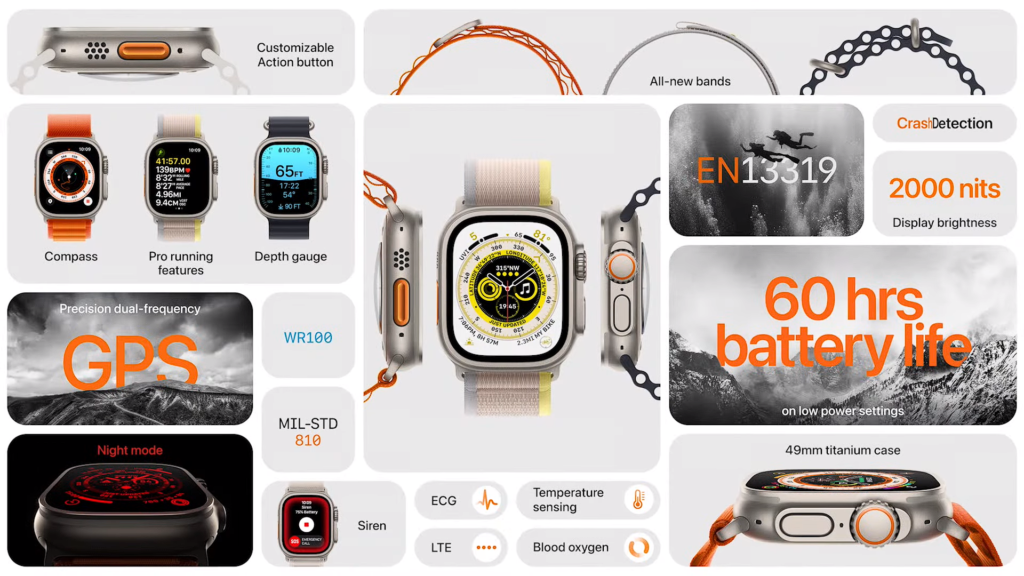The Watch Ultra is the first major ground-up redesign of the Apple Watch as we know it. So when Apple suggested that Stuff sit down (well, virtually) with three of the company’s vice presidents to ask them about the key sensors on the device, we didn’t have to think about it very long.
We spoke to Stan Ng, VP for Apple Watch marketing; Ron Huang, VP for sensing and connectivity; and Jay Blahnik, VP of fitness technologies. So, first things first: Why is now the right time for the Watch Ultra?
“Over the years we’ve heard from customers who shared with us how they wanted to use Apple Watch for their extreme adventures,” explains Stan Ng. “We wanted to create a watch that would be a meaningful tool, and it was driven by three use cases: endurance athletics, outdoor adventure, and exploring the ocean.”
Push hour
The action button is one of the key new features of the Watch Ultra – but why have a dedicated button? “When we thought about the ultra-endurance athlete, it made a lot of sense to have a button that you can dedicate to do things during a workout without touching the screen,” explains fitness guru Jay Blahnik.
“If you put together a custom workout – let’s say you you’re doing 30-second intervals followed by one-minute recoveries and you want to move past a recovery or an interval. You can do that manually by pushing the action button. When you’re doing custom workouts, you don’t want to have to look at the screen.”
A multi-sport feature helps athletes doing any configuration of swimming, biking, and running and automatically detects when you’re doing those activities. “But we know there are endurance athletes who are very, very picky about the exact time they consider their swim stopping and their transition time starting, and then their bike ride starting. So you can even flip into manual mode and use the action button for that.”
You’re also able to use the button to get a precise start time, while the Watch Ultra’s screen can display six metrics at any one time.
“So perhaps you want time, pace, distance, and heart rate, but you also at certain times of the run want to focus on our new running metrics like vertical oscillation, ground contact time, or stride length. You can have a secondary screen and, with one scroll of the digital crown, it flips to that.”
Follow two, follow me
 One of the major upgrades on the Watch Ultra is its dual GPS. Of course, everyone’s been relying on GPS for a long time, but most of that has been on the L1 frequency, which is now almost 50 years old. L5 is the upgrade tech to GPS; the two frequencies are designed to complement each other, but L5 has been limited to a selection of smartphones as well as devices like Garmin’s dedicated GPSMAP adventure trackers.
One of the major upgrades on the Watch Ultra is its dual GPS. Of course, everyone’s been relying on GPS for a long time, but most of that has been on the L1 frequency, which is now almost 50 years old. L5 is the upgrade tech to GPS; the two frequencies are designed to complement each other, but L5 has been limited to a selection of smartphones as well as devices like Garmin’s dedicated GPSMAP adventure trackers.
“If you think about how GPS works, it’s computing the distance between you and satellites that are 20,000km above you,” explains Huang. “It does that by very precise timing between the satellites and your watch, with signals travelling at the speed of light. So it’s easy to incur some error from passing through the atmosphere. The ionosphere has a lot of plasma that disrupts the radio waves, for example. Because L1 and L5 are 400MHz apart, you can correct for that.”
Blahnik cites the Boston Marathon as an example of where the watch can come into its own: “A good proportion of the marathon is run in the middle of the city’s skyscrapers, where L1 can be compromised.”
Homeward found
Backtrack is a new feature of the Compass app that enables you to retrace your steps using the Watch Ultra if you get lost. As Huang points out, often you don’t know you’re lost until it’s too late. So Backtrack has an automatic mode that he calls a ‘safety net’.
“We built a wilderness detector, if you will. We look at Wi-Fi signals, because when there’s no Wi-Fi today it’s likely to be wilderness. We also look at your past usage to see if it’s a place you’ve been before. We even remember when you went from driving to walking, as that’s probably where you want to get back to. So the watch automatically starts recording the trace for you. We can do that with very minimal battery impact.”
“The Apple Watch has become essential for so many users now,” adds Ng. “And they want to use it everywhere they go – including mountains, deserts, and the ocean. We think they’re going to be very excited about the Ultra.”
Words: Dan Grabham




